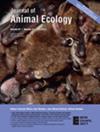Selective logging weakly influences species co-occurrence in a community of tropical understorey birds
IF 3.7
1区 环境科学与生态学
Q1 ECOLOGY
引用次数: 0
Abstract




选择性采伐对热带林下鸟类群落物种共现的影响较弱。
选择性采伐是热带土地利用变化的主要驱动因素,导致森林专用物种减少,同时耐边缘物种增加。一个关键的问题是了解选择性采伐如何影响森林采伐后恢复时脊椎动物群落的共生和聚集机制。通过对婆罗洲林下鸟类物种进行为期10年的重复样本研究,我们比较了原始未砍伐森林和砍伐森林之间物种共现的结构,研究了功能特征和当地丰度在驱动共现模式中的作用。随着时间的推移,共生模式对选择性采伐具有弹性,尽管两种森林类型中所有物种的模式并不一致。在这两种类型的森林中,饮食更专业化的物种表现出明显的低保真度趋势,而从事空中觅食、翱翔和滑翔的物种则表现出明显的低保真度趋势。共生模式的变化也受到当地丰度变化的显著影响。研究结果表明,生态位分离和环境过滤作用于两种森林类型的鸟类群落组合,但随着时间的推移,共生对选择性采伐具有弹性。我们的研究结果还强调了一些物种在调节鸟类群落中的作用以及热带砍伐森林的长期保护价值。
本文章由计算机程序翻译,如有差异,请以英文原文为准。
求助全文
约1分钟内获得全文
求助全文
来源期刊

Journal of Animal Ecology
环境科学-动物学
CiteScore
9.10
自引率
4.20%
发文量
188
审稿时长
3 months
期刊介绍:
Journal of Animal Ecology publishes the best original research on all aspects of animal ecology, ranging from the molecular to the ecosystem level. These may be field, laboratory and theoretical studies utilising terrestrial, freshwater or marine systems.
 求助内容:
求助内容: 应助结果提醒方式:
应助结果提醒方式:


